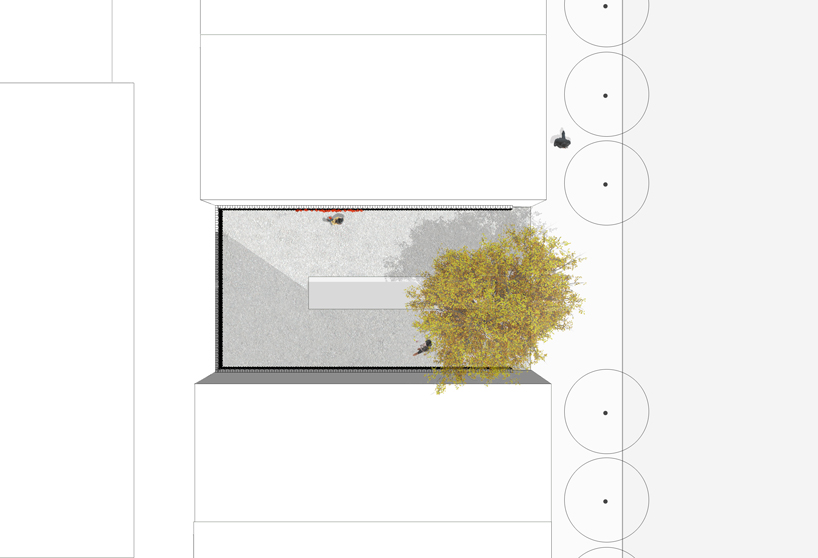
The Living Spaces Project by Emily Waugh from canada
designer's own words:
The Living Spaces Project
“Life gives way into death. Then death turns around and gives way into life”
The notion ‘Out of death comes life” is present across cultures around the world and offers solace and hope to the bereaved for the potential of new beginnings. Just as the soldiers of WW2 witnessed previously dormant poppies suddenly appear as symbols of life and hope out of the freshly dug graves in Flanders, we can look to the often unrecognized vibrancy of cemeteries as a way to generate new life in our cities.
Cemeteries, memorials, and spaces of remembrance have given the world some of its most vivid and beautiful physical environments. These powerful landscapes support and encourage the dynamic and varied rituals of death, bereavement, and memorial across cultures.
From the Dogon funeral dance of Mali, to the Day of the dead in Mexico, from the Hindu food offerings of Pitrupashka to the Qingming festival or gravesweeping day in China, the rituals of remembrance and celebrations of life, provide a constantly changing landscape of visual stimulation and cultural vitality. Some of these rituals are spontaneous and temporary; some fleeting and ephemeral; some marked by a single day each year; others lasting weeks or even months; some ongoing. With each day these rituals bringing new life to the spaces around them.
In addition, as the cities around cemeteries continue to grow and densify, these spaces are returning to their role, not only as places for the rituals of death, but as central places for the rituals of daily life. More and more, we see cemeteries being used for a range of social activities, performances, and special events, bringing additional layers of life to these already animated spaces.
Combining this inherent vitality with the need to reconsider the spatial demands of burial and memorial, The Living Spaces Project identifies vacant, leftover, or so-called ‘dead spaces ‘ within the city and brings them to life with a network of vibrant urban spaces designed to support and encourage the rituals of death and the rituals of daily life. These intimate public spaces activate the city with the energy of daily users, annual rituals, special events, and the constantly evolving exhibition of dynamic visual displays. The flexible spaces are designed to be both personal and shared, still and dynamic, quiet and full of life — capable of promoting collective experiences and private reflections.
Bricks, a Bench, and a Tree
These modular spaces are constructed from a simple formula of memorial bricks plus a bench, plus a tree and are easily adaptable to almost any site, any location, or any climate. Cremated remains are placed directly into interlocking memorial bricks, which are used to construct the faceted walls that frame the space. Using these brick urns as a structural element fuses the space between death and remembrance and reduces the space between bereavement and renewal as the remains of loved ones become, literally, the building blocks of new life in the city. The bricks feature an angled front face that – when stacked- supports a variety of rituals and memorial functions and is intended to serve the varied needs of different cultures, customs, and practices. A ledge holds candles, idols and other ritual offerings; a small opening serves as a vase for flowers. And a hook, on the underside of each brick provides a place to hang wreaths, flower garlands, and charms.
The Bench
In the Living Spaces project, every site is outfitted with an oversized bench that can accommodate anything from a large crowd of mourners, to small groups, to daily users of the space. The large, flat slab, also serves as a surface for offerings, ritual communal meals, or community gatherings. A large cut-out at one end, leaves space for the final element: The tree.
The Tree
Known in many cultures as a sign of hope, eternity, and new beginnings, the presence of the tree brings a new kind of life to the site.
Its leaves provide shade for visitors, its branches offer an armature to support ceremonial decorations. And its seasonal variations in colour and texture join the chorus of dynamic life in the space. As the tree grows and the spaces are adopted into the daily lives of their host cities, the spaces will take on new lives of their own, bringing with them new rituals of death and new rituals of life.
As the Living Spaces Project aggregates into a larger urban network, they will breathe new life into the city as they continue to act as condensers and generators of urban life and as they continue to grow and evolve with the changing city.
Space activated by annual festival
A moment of private reflection
[jwplayer config=”mplayer” width=”818px” height=”600px” file=”https://static.designboom.com/wp-content/compsub/377521/2013-09-01/video_1_1378078499_f9d13b4952a4b476936b764ee969720d.flv” html5_file=”https://static.designboom.com/wp-content/compsub/377521/2013-09-01/video_1_1378078499_f9d13b4952a4b476936b764ee969720d.flv” download_file=”https://static.designboom.com/wp-content/compsub/377521/2013-09-01/video_1_1378078499_f9d13b4952a4b476936b764ee969720d.flv”]
video

A space of remembrance
Space activated at night by memorial lanterns
Holiday recreation mingles with spaces of remembrance
Plan of a prototypical, modular example of the ‘Living Space Project’